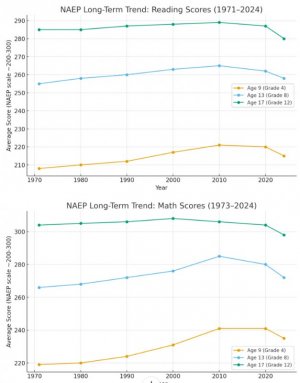Knight
Well-known Member
US test scores hit damning new lows in math, reading since COVID school closures, ‘nation’s report card’ shows.
The writing’s on the wall — if you can read it.
Sobering national test results show more high school seniors are struggling with math and reading than at any point in recent decades, with Education Secretary Linda McMahon calling out a “devastating trend” Tuesday.
The National Assessment of Educational Progress (NAEP) — commonly referred to as the Nation’s Report Card — showed just 35% of high school seniors were proficient in reading, the lowest score since the assessment began in 1992.
US test scores hit damning new lows in math, reading since COVID school closures, ‘nation’s report card’ shows
U.S. Department of Education (.gov)
aaec › about-the-us-department-of-education
ED's 4,400 employees and $68 billion budget are dedicated to: Establishing policies on federal financial aid for education, and distributing as well as ...
Their Mission Statement.
About ED
Overview and Mission Statement
ED's mission is to promote student achievement and preparation for global competitiveness by fostering educational excellence and ensuring equal access.
ED was created in 1980 by combining offices from several federal agencies. ED's 4,400 employees and $68 billion budget are dedicated to:
Establishing policies on federal financial aid for education, and distributing as well as monitoring those funds.
Collecting data on America's schools and disseminating research.
Focusing national attention on key educational issues.
Prohibiting discrimination and ensuring equal access to education.
Office of Elementary and Secondary Education
IMO they are failing in their mission.
The writing’s on the wall — if you can read it.
Sobering national test results show more high school seniors are struggling with math and reading than at any point in recent decades, with Education Secretary Linda McMahon calling out a “devastating trend” Tuesday.
The National Assessment of Educational Progress (NAEP) — commonly referred to as the Nation’s Report Card — showed just 35% of high school seniors were proficient in reading, the lowest score since the assessment began in 1992.
US test scores hit damning new lows in math, reading since COVID school closures, ‘nation’s report card’ shows
U.S. Department of Education (.gov)
aaec › about-the-us-department-of-education
ED's 4,400 employees and $68 billion budget are dedicated to: Establishing policies on federal financial aid for education, and distributing as well as ...
Their Mission Statement.
About ED
Overview and Mission Statement
ED's mission is to promote student achievement and preparation for global competitiveness by fostering educational excellence and ensuring equal access.
ED was created in 1980 by combining offices from several federal agencies. ED's 4,400 employees and $68 billion budget are dedicated to:
Establishing policies on federal financial aid for education, and distributing as well as monitoring those funds.
Collecting data on America's schools and disseminating research.
Focusing national attention on key educational issues.
Prohibiting discrimination and ensuring equal access to education.
Office of Elementary and Secondary Education
IMO they are failing in their mission.


